ARCHIVED WEBPAGE: This web page is available for historical purposes. CDC is no longer updating this web page and it may not reflect CDC's current COVID-19 guidance. For the latest information, visit CDC's COVID-19 home page.
Aquatics FAQs
Recommendations for Fully Vaccinated People
COVID-19 Homepage
Improve the Fit and Filtration of Your Mask to Reduce the Spread of COVID-19
Correct and consistent mask use is a critical step everyone can take to reduce their risk of getting and spreading COVID-19. Masks work best when everyone wears them, but not all masks provide the same protection. How well a mask fits, how well it filters the air, and how many layers it has are all important to consider when choosing which mask to wear. Wearing a mask around people who do not live with you or when someone in your house is sick is now even more critical with the increased spread of new COVID-19 variants, some of which appear to spread more easily and quickly than the original virus that causes COVID-19.
General Principles for Mask Use
Below are some general principles for mask use.
Masks should
- Completely cover the nose and mouth
- Fit snugly against the sides of the face and not have any gaps
- Be handled only by the ear loops, cords, or head straps (not by the surface of the mask)
Masks should be worn
- Any time you are in a public setting
- Any time you are traveling on a plane, bus, train, or other form of public transportation traveling into, within, or out of the United States and in U.S. transportation hubs such as airports and stations
- When you are around people who do not live with you, including inside your home or inside someone else’s home
- Inside your home if someone you live with is sick with symptoms of COVID-19 or has tested positive for COVID-19
Masks should not be worn
- By a child under 2 years of age
- By someone with a disability who cannot wear a mask, or cannot safely wear a mask, for reasons related to the disability
- In a situation when wearing a mask would create a risk to workplace health, safety, or job duty as determined by the workplace risk assessmentexternal icon
For more information on wearing a mask and personal protective equipment in healthcare workplaces, see Interim Infection Prevention and Control Recommendations for Healthcare Personnel During the Coronavirus Disease 2019 (COVID-19) Pandemic.
Types of Masks
There are many types of masks that you can use to protect yourself and others from getting and spreading COVID-19. The terminology used to describe masks is NOT standardized. The terms and definitions provided here might be different from the terms and definitions that are used for commercial products. A brief description of different types of masks and some of the pros and cons of each are described below.
Cloth Masks
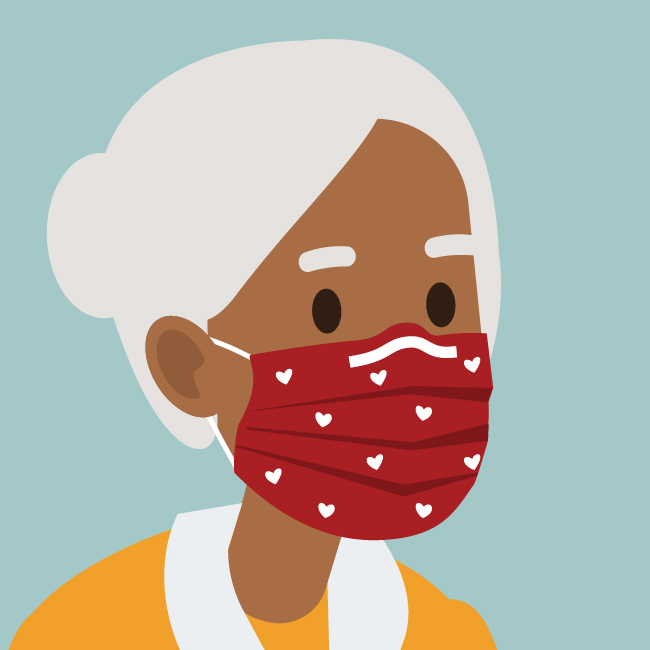
Cloth masks can be made from a variety of natural and synthetic fabrics and fibers, and many types of cloth masks are available.
What to look for
- Look for a cloth mask that is made of multiple layers of tightly woven, breathable fabric.
- Make sure your cloth mask blocks light from coming through the fabric if held up to a bright light source.
Features
- Can have ear loops that fit behind the ears or cords that tie around the head and neck.
- Some have a nose wire (a metal strip along the top of the mask) that can help to improve fit.
- Note: Do NOT wear cloth masks with exhalation valves or vents since they allow respiratory droplets containing the virus to escape.
Pros: Easy to obtain; comfortable; affordable; convenient; washable and reusable; ear loops, tie cords, and nose wires (if available) can usually be adjusted.
Cons: Poorly fitting masks may have gaps around the sides of the face or nose. Gaps may allow respiratory droplets containing the virus to leak in and out around the mask. Depending on how they fit and how they are made, cloth masks vary in how well they can protect you and others from getting and spreading COVID-19.
Additional Considerations: A cloth mask can be layered on top of a medical procedure mask for improved fit and filtration. Using a mask fitter or brace may also help to improve fit.
Medical Procedure Masks (sometimes referred to as Surgical Masks or Disposable Face Masks)
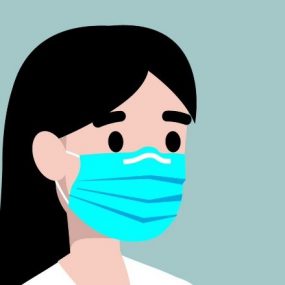
Medical procedure masks (including surgical masks) intended for community use are commercially available and are often sold as “disposable face masks.”
What to look for
- Check the labels to ensure that they are made of multi-layered, non-woven material.
Features
- Generally have ear loops that fit behind the ears. However, some available options have cords that tie around the head and neck rather than ear loops.
- Some have a nose wire (a metal strip along the top of the mask) that can help to improve fit.
Pros: Easy to obtain; comfortable; affordable; convenient; disposable (good for situations when the mask may get wet or dirty); nose wires (if available) can be adjusted.
Cons: These masks often fit loosely. Masks with ear loops may not be adjustable enough to achieve a better fit. Masks with tie cords can provide a better fit for some people. Poor fit causes gaps around the nose and along the sides of the face where respiratory droplets containing the virus can leak in and out; designed for one-time use.
Additional Considerations: A medical procedure mask can be layered underneath a cloth mask for improved fit and filtration. However, a medical procedure mask should not be layered underneath a second medical procedure mask. Using a mask fitter or brace may also help to improve fit
KN95 Masks (also known as KN95 Respirators)
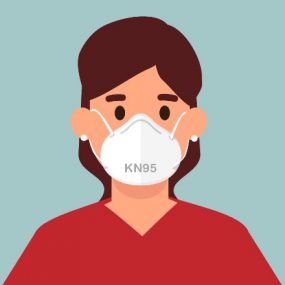
KN95 masks are a type of filtering facepiece respirator that are commonly made and used in China. KN95 masks may be preferable in some situations or for some people – especially for situations that require prolonged close contact with people who do not live in the same household, or for people who are at increased risk for severe illness from COVID-19.
What to look for
- Look for KN95 masks that meet requirements similar to those set by CDC’s National Institute for Occupational Safety and Health (NIOSH) for respirators. Some KN95 masks sold in the United States meet requirements similar to those set by NIOSH, while other KN95 masks do not.
Features
- Often have ear loops that fit behind the ears. However, some available options have head straps.
- Note: Do NOT wear KN95 masks with exhalation valves since they allow respiratory droplets containing the virus to escape.
Pros: Filter up to 95% of particles in the air (when they meet the right requirements and are not counterfeit/fake, and when proper fit can be achieved).
Cons: Can be uncomfortable; often requires more effort to breath; may be more expensive and difficult to obtain; designed for one-time use; many counterfeit (fake) KN95 masks are commercially available, and sometimes it is hard to tell if they meet the right requirements just by looking at them. At least 60% of the KN95 masks evaluated by NIOSH did not meet the requirements that they claim to meet.
Additional Considerations: It may be hard to achieve a proper fit with certain types of facial hair.
NIOSH-Approved N95 Respirators
CDC does not recommend the use of N95 respirators for protection against COVID-19 in non-healthcare settings. N95 respirators should be prioritized for healthcare personnel and for other workers who are required to wear them for protection against other hazards.
Ways to Increase Mask Protection: Improve Fit and Filtration
- Improve fit to help prevent air (potentially with respiratory droplets containing the virus) from flowing freely around the edges of the mask and instead forcing air to flow through the mask.
- Improve filtration to cause more respiratory droplets containing the virus to be captured by the mask.
How to Improve Fit
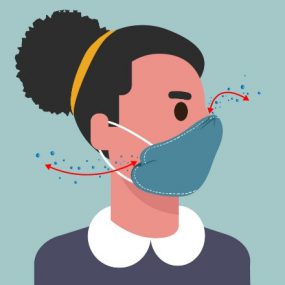
COVID-19 spreads mainly from person to person through respiratory droplets that come out of the nose and mouth when people breathe, cough, sneeze, talk, shout, or sing. These respiratory droplets travel in the air and can then land in the noses and mouths of others, which spreads COVID-19. Therefore, in order to be effective, masks must always be worn over the nose and mouth.
Ensuring that masks fit well on the face is very important to help prevent getting and spreading COVID-19. A common problem with some masks is that there can sometimes be gaps between the mask and the mask wearer’s face. When there are gaps, air with respiratory droplets containing the virus can leak in and out around the edges of the mask (on the top or the sides). To help prevent air leakage, masks should fit snugly against the sides of the face and not have gaps.
Options to Improve Mask Fit
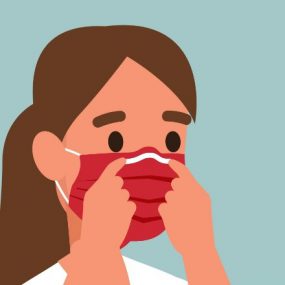
Nose Wires: Use cloth or medical procedure masks that have a nose wire (a metal strip along the top of the mask) to help prevent air leakage at the top of the mask. Nose wires can also help to prevent fogging of eyeglasses. To get a good fit, make sure to bend the nose wire over your nose to conform to your face.
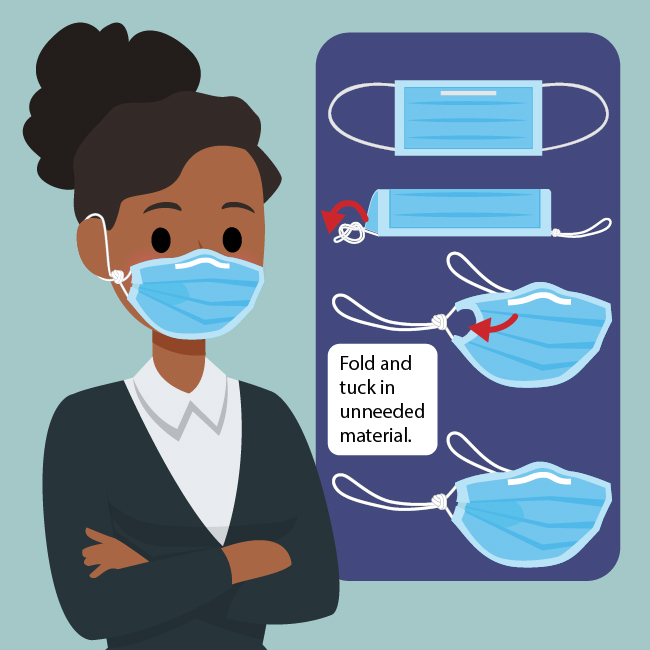
Knotting and Tucking: This technique can be used to improve the fit of a medical procedure mask. Knot the ear loops of the mask where they join the edge of the mask, then fold and tuck the unneeded material under the edges. (For instructions, see the following https://youtu.be/GzTAZDsNBe0external icon)
How to Check Mask Fit
- Check for gaps by cupping your hands around the outside edges of the mask. Make sure no air is flowing from the area near your eyes or from the sides of the mask.
- If the mask has a good fit, you will feel warm air come through the front of the mask and may be able to see the mask material move in and out with each breath.
Other things to consider
Certain types of facial hair, like beards, can make mask fitting difficult. People with beards can do one or more of the following:
- Shave their beards.
- Trim their beards close to the face.
- Use a mask fitter or brace.
- Wear one disposable mask underneath a cloth mask that has multiple layers of fabric. The second mask should push the edges of the inner mask snugly against the face and beard.
Masks designed for people with beards are being evaluated, and information will be provided when it becomes available.
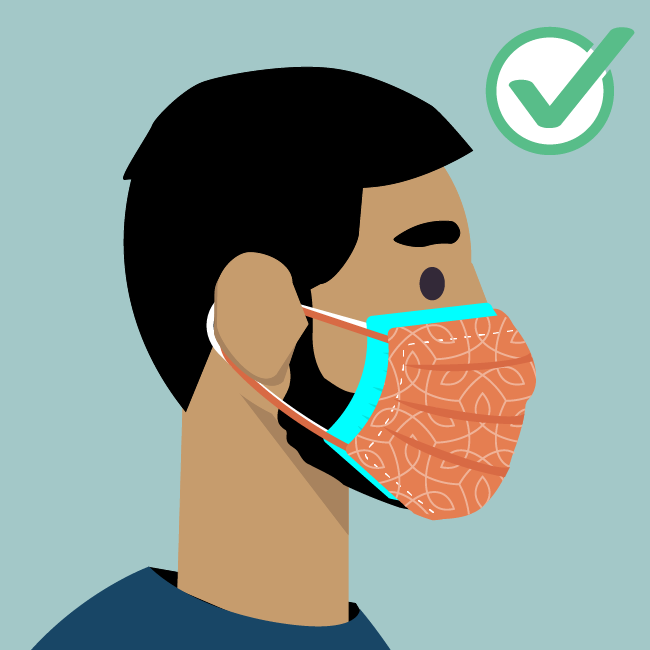
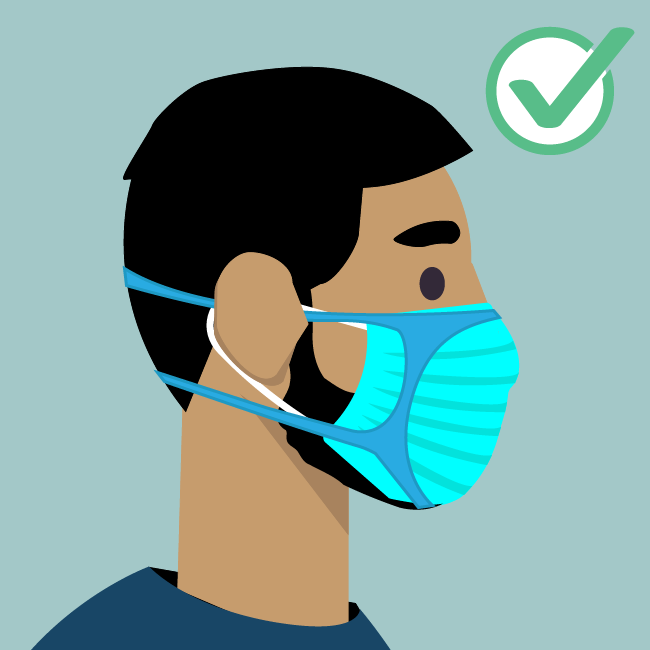
How to Improve Filtration
Another important step to increase the protection offered by your mask is to improve filtration. Masks capture respiratory droplets containing the virus when the wearer breathes out, blocking them from reaching the outside air and protecting others. They also serve as a barrier to protect the wearer by capturing respiratory droplets containing the virus breathed out by others, so that the wearer does not breathe them in. A mask with improved filtration will stop more respiratory droplets containing the virus from getting inside your mask if others are sick or escaping from your mask if you are sick.
Layering
Adding more layers of material to a mask (layering) is a good way to reduce the number of respiratory droplets containing the virus that come through the mask. One layering strategy is to use a cloth mask that has multiple layers of fabric. Another strategy is to wear two masks.
Improve Mask Fit and Filtration by Wearing Two Masks
Wearing a second mask on top of a first mask can
- Improve fit by pressing the inner mask closer to the face, thereby reducing the amount of air that leaks around the edges of the masks.
- Improve filtration by adding more layers of material to reduce the number of respiratory droplets containing the virus that come through the masks.
One way to do this is to wear a medical procedure mask underneath a cloth mask. A recent study conducted in a laboratory found that this combination provided much better protection to the wearer and to others as compared with a cloth mask by itself or a medical procedure mask by itself.
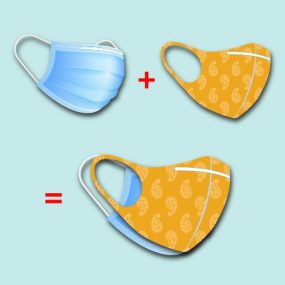
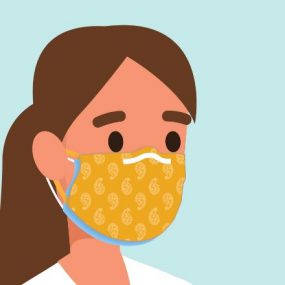
However, there are some mask combinations that should not be used
- Do not combine two medical procedure masks. Medical procedure masks are not designed to fit tightly and wearing a second medical procedure mask on top of the first medical procedure mask does not help to improve the fit.
- Do not combine a KN95 mask with any other masks. You should only use one KN95 mask at a time, and you should not use any type of second mask on top of or underneath a KN95 mask.
Things to Watch Out for When Improving Mask Fit and Filtration
Take into account the following considerations when improving mask fit and filtration:
Ensure the following
- Breathing is not difficult
- Breathing might take more effort when wearing a mask that fits and filters better. For example, it might require more effort to breathe when wearing two masks.
- Vision is not obstructed
- Adding an extra layer or mask could block vision. Reduced vision could lead to trips, falls, or other injuries.
Try it at home first
- Try out any potential techniques for improved mask fit and filtration at home before trying it out in public. For example, try walking around the house or outside for several minutes while wearing a mask with improved fit and filtration to assure that you can breathe comfortably and that your vision is not reduced.
Special considerations for children who may have difficulties with techniques for improved fit and filtration
- Children younger than 2 should not wear any masks.
- Children 2 and older should always wear masks in a public setting or when they are around people who do not live with them.
- Some children (age 2 and older) may tolerate wearing one mask without any problems but may not be able to tolerate improved fit and filtration techniques.
Choosing a Mask for Different Situations
Some situations may have higher risk of exposure to COVID-19 than others, so the level of protection needed may vary.
In many circumstances, cloth masks or medical procedure masks work well for community use.
Examples might include:
- Talking with neighbors when you are outdoors and are at least six feet away
- Going to a park, as long as you are able to stay at least six feet away from people who do not live with you
For situations when you are in close contact with people who do not live with you, a mask option that provides a higher level of protection (improved fit and/or improved filtration) should be considered.
These situations might include
- Going to the grocery store
- Visiting the doctor
- Working at a job where you are exposed to people who do not live with you and you are not always able to maintain at least six feet of distance from others
One example of an option to improve fit is to use a mask fitter or brace over a medical procedure mask or a cloth mask (as described above) in order to reduce leakage of air around the edges of the mask. Another example of an option that can improve fit and filtration is to wear two masks, which can be done by wearing a cloth mask over a medical procedure mask.
For some situations, especially those that require prolonged close contact with people who do not live with you, you may prefer to use a KN95 mask identified on the FDA Emergency Use Authorization Listexternal icon.
These situations might include
- Riding on planes, buses, trains, or other forms of public transportation, especially when you are not able to maintain at least 6 feet of distance from other people who do not live with you
- Taking care of someone who is sick with COVID-19
- Working at a job where you interact with large numbers of the public, especially if you work in areas with high levels of community transmission. Examples of jobs might include bus drivers and grocery store workers
People at increased risk for severe illness from COVID-19, such as older adults or people with certain underlying medical conditions, may prefer to use a KN95 mask when interacting with people who do not live with them.
A KN95 mask might not always be available when you wish to have a higher level of protection, or you may not be able to properly fit or tolerate a KN95 mask. In that case, you can use a mask fitter or brace over a medical procedure mask or a cloth mask to improve fit. Another option is to improve fit and filtration by wearing two masks to increase protection.
Choosing and Wearing a Mask is Just One of Many Strategies to Reduce the Spread of COVID-19
Wearing a mask is one of the most important ways to reduce the risk of getting and spreading COVID-19. This document describes the types of masks available and strategies that can be used to better protect the wearer and the people they interact with. Wearing any type of mask correctly is better than not wearing a mask at all.
This guidance should be used to help inform people’s choice of mask and level of protection. CDC recommends that people consistently and correctly wear masks in all public settings, when they are with anyone who does not live with them (including inside their own home), and when taking care of someone who has COVID-19.
In addition to consistently and correctly wearing masks, everyone should continue to take these important steps to reduce the spread of COVID-19:
- Stay at least 6 feet (at least 2 arm lengths) away from others who do not live with you
- Avoid crowds
- Avoid poorly ventilated indoor spaces
- Stay home when you are sick
- Wash hands frequently with soap and water for at least 20 seconds (or use hand sanitizer containing at least 60% alcohol)
- Get vaccinated when the vaccine is available to you
- Get tested if you have signs or symptoms of COVID-19, or if you think you may have been exposed to someone with COVID-19
General Information about Masks
- Your Guide to Masks
- How to Wear Masks
- How to Store and Wash Masks
- Guidance for Wearing Masks
- Scientific Brief: Community Use of Cloth Masks to Control the Spread of SARS-CoV-2
- Requirement for Face Masks on Public Transportation Conveyances and at Transportation Hubs
Mask and Respirator Standards
- Masks and Respirators that have received FDA Emergency Use Authorizations (EUAs)external icon
- American Society for Testing and Materials: ATSM Standards & COVID-19external icon
- NIOSH-Approved N95 Particulate Filtering Facepiece Respirators
Information about Counterfeit (Fake) Masks and Respirators
- The National Personal Protective Technology Laboratory (NPPTL) Respirator Assessments to Support the COVID-19 Response
- Factors to Consider When Planning to Purchase Respirators from Another Country
- Information about Counterfeit Masks and Respirators
Scientific Studies about Wearing Masks
- Brooks JT, Beezhold DH, Noti JD, et al. Maximizing Fit for Cloth and Medical Procedure Masks to Improve Performance and Reduce SARS-CoV-2 Transmission and Exposure, 2021. MMWR Morb Mortal Wkly Rep. ePub: 10 February 2021. DOI: http://dx.doi.org/10.15585/mmwr.mm7007e1external icon
- Rothamer DA, Sanders S, Reindl D, Bertram TH. Strategies to minimize SARS-CoV-2 transmission in classroom settings: Combined impacts of ventilation and mask effective filtration efficiencyexternal icon. Preprint. MedRxiv. 2021; Posted 2021 January 4. doi:10.1101/2020.12.31.20249101
- Gandhi M, Marr LC. Uniting Infectious Disease and Physical Science Principles on the Importance of Face Masks for COVID-19external icon. Med. 2021;2(1):29-32. doi: 10.1016/j.medj.2020.12.008
- Pan J, Harb C, Leng W, Marr LC. Inward and outward effectiveness of cloth masks, a surgical mask, and a face shieldexternal icon. MedRxiv. 2020; Posted 2020 November 20. doi:10.1101/2020.11.18.20233353
- Runde DP, Harland KK, Van Heukelom P, Faine B, O’Shaughnessy PO, Mohr NM. The “double eights mask brace” improves the fit and protection of a basic surgical mask amidst COVID‐19 pandemicexternal icon. J Am Coll Emerg Physicians Open. 2020;2(1):e12335. Published 2020 Dec 26. doi:10.1002/emp2.12335
- Lindsley WG, Blachere FM, Law BF, Beezhold DH, Noti JD. Efficacy of face masks, neck gaiters and face shields for reducing the expulsion of simulated cough-generated aerosolsexternal icon. Aerosol Sci Technol. 2021; doi:10.1080/02786826.2020.1862409
- Noti JD, Lindsley WG, Blachere FM, et al. Detection of infectious influenza virus in cough aerosols generated in a simulated patient examination roomexternal icon. Clin Infect Dis. 2012;54(11):1569-1577. doi:10.1093/cid/cis237
- Clapp PW, Sickbert-Bennett EE, Samet JM, et al. Evaluation of Cloth Masks and Modified Procedure Masks as Personal Protective Equipment for the Public During the COVID-19 Pandemicexternal icon. JAMA Intern Med. 2020;e208168. Published online ahead of print 2020 Dec 10. doi:10.1001/jamainternmed.2020.8168
